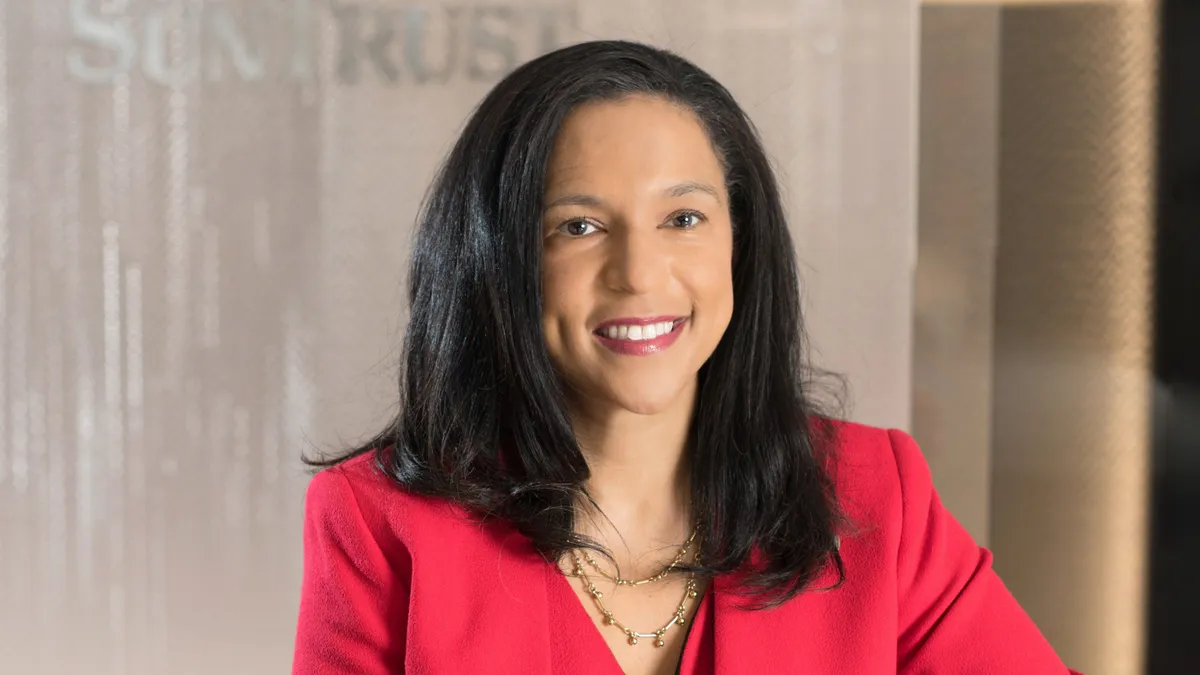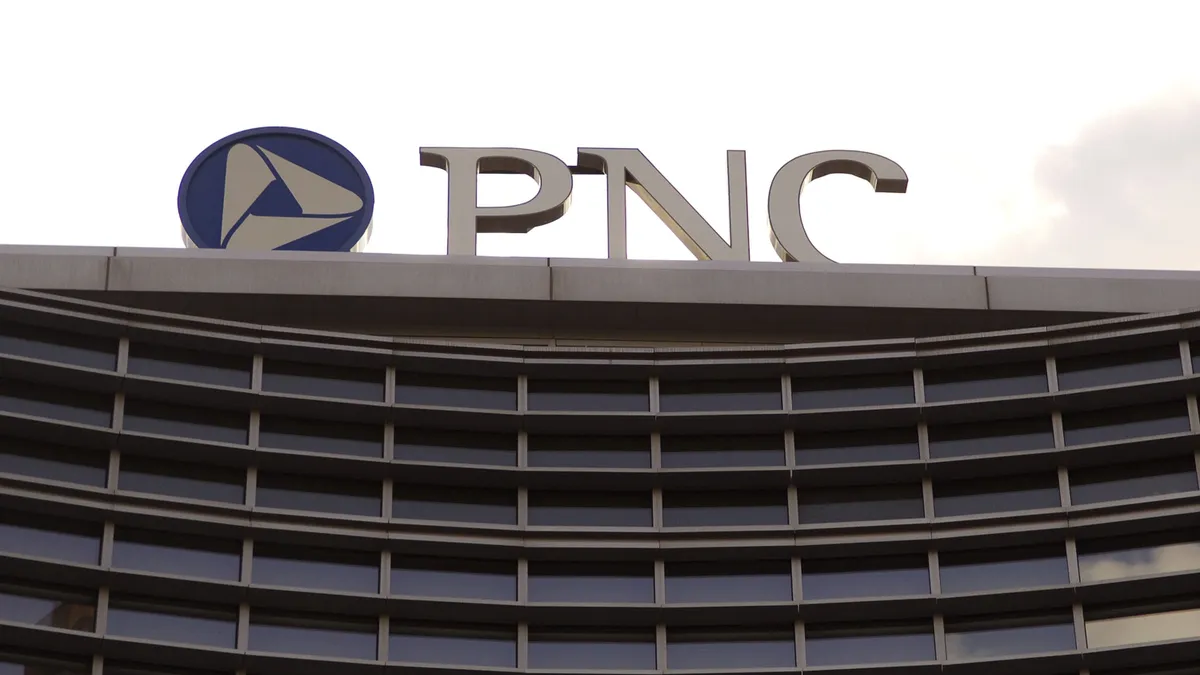Susan Somersille Johnson went to school to be an engineer, yet somehow managed to carve out a nearly 30-year career in marketing.
For the past five years, the Harvard and Massachusetts Institute of Technology grad has headed the marketing efforts at SunTrust, one of the largest banks in the competitive Southeast market.
"I did a 180," Johnson told Banking Dive, on her decision to pursue a career in marketing over tech and engineering.
She made the shift early in her career, while she was a few years into her job at Apple.
"Somebody suggested it to me. They said, 'You should think about marketing, because [Apple] is such a strong marketing company.' I had not taken one class in marketing. But if you're going to learn marketing, that's a great place to do it," Johnson said. "So I tried a role and I never looked back. … As an engineer, you're used to the bits and bytes, the numbers. Marketing is so ephemeral and I didn't realize the impact you can have. You can change behaviors, you can change what people do with marketing. That's really powerful."
BB&T announced in February that it would acquire SunTrust in a deal valued at $66 billion. The deal, which is expected to close this quarter, would create Truist, the nation's sixth-largest bank.
Johnson, who will transition to the role of chief marketing officer of Truist, sat down with Banking Dive to talk about fintech partnerships, the challenges that come with a major rebrand, and how tech is transforming the bank's marketing efforts.
This interview has been edited for clarity and brevity.
BANKING DIVE: What are the challenges that come with marketing a financial institution?
SUSAN SOMERSILLE JOHNSON: I don't know that it’s different for financial institutions than for any other organization, but it's measuring the outcomes of marketing. So if you spend X million dollars, how much will that make in sales and growth of the organization? That is like the holy grail. Marketers are always chasing that. So that is the biggest challenge. For financial services, one of the things that I never experienced before was the regulations and the compliance aspect of it. … Everything that we produce goes through legal and compliance, just to make sure that we have the right disclaimers and that we're saying things in the right terms. Everything that we do goes through that lens, which is different than my previous experience.
Once the SunTrust-BB&T deal takes place, the combined entity will be named Truist. What kind of challenges come with a major rebrand like this?
JOHNSON: The main goal in the beginning is to increase awareness of brand recognition and brand consideration for Truist. We announced the name Truist in July, and before that, it had zero brand awareness. So our goal now is to build the awareness before what we call, "client day one," which is when BB&T and SunTrust become Truist. … It's a fascinating case. Everything changes. Everything has to be updated. So we're working on timing. What are the new names? What are the timings? And we're still working with Interbrand on that with the brand architecture, the main sub-brands, all the products and all the sponsorship deals.
How did you come up with the new name?
JOHNSON: The month after we announced, we selected Interbrand as our lead agency to work on the new branding. We interviewed people inside both organizations and stakeholders of both organizations, and did a lot of client and prospect interviews. … It was a whirlwind effort. It was very rewarding, because when you're creating a new brand, you are looking for the best of both organizations. You get to ask people, what do you like about BB&T? What do you like about SunTrust? What do they do for you? And it was exciting.
How does technology play a role in marketing the bank?
JOHNSON: We're using [artificial intelligence] to dynamically identify target segments. When you think of marketing, you think traditional segmentation. You have different segments of clients and you market to them differently. And you give them different messages depending on what they need or what they want. So we were doing that. And then we have a very strong analytics team. And they are using algorithms to determine exactly what messages should go to which client. We're investing in that and learning more about our clients and giving them the right messages. Then we said, "Let's turn AI on this and see what that can do." And so what that does is, it learns by itself and tests with different client bases. It creates segments of clients on the fly automatically.
Let's say a client has decided to buy a new home and she's searching for a mortgage. We can identify that on the fly and get the right messages to her immediately. The traditional segmentation that is static and well defined now is dynamically changing every minute on our website as the engine is learning. That's exciting for a marketer because it's a whole different world than five years ago.
What's the most rewarding part of your job?
JOHNSON: We just had a major milestone, so that's really easy to answer now. In 2016, we launched our onUp Movement. We wanted to reach 5 million people in five years. We actually count how many people have literally taken a step and action toward financial confidence. And a couple of weeks ago, we reached 5 million people ahead of schedule. We have a lot of people who have given testimonials and videos about their journeys, and it's really rewarding.
What kind of fintech partnerships does SunTrust have?
JOHNSON: One of them that is really rewarding and doing well for us is with Greenlight, a smart debit card for kids. It helps parents monitor their spending, but also teaches them a little bit about money management. … We also partnered with a technology provider to develop a new app called SmartGUIDE. SmartGUIDE is for people looking for a home. There's so much to do when you're looking for a home that it can be overwhelming, so SmartGUIDE helps people in the application process cut the time it takes to apply for a mortgage by 50%.
There are so many fintechs looking to team up with banks. How does SunTrust vet those partnerships?
JOHNSON: It's a lot. So we began a process where it's very methodical and strategic. We start with asking, what are our strategic needs? What are the capabilities that we need that we don't have? And then we start talking to fintechs. It can be quite overwhelming because there's always something new. So we went back and started with, what are our needs? And then we try to map the vendors that we see into the right area, and then see how far we get in the discussions.






















